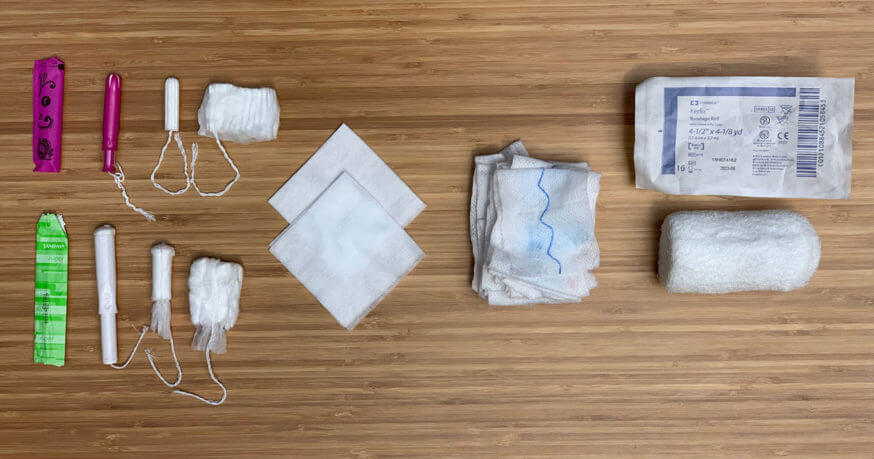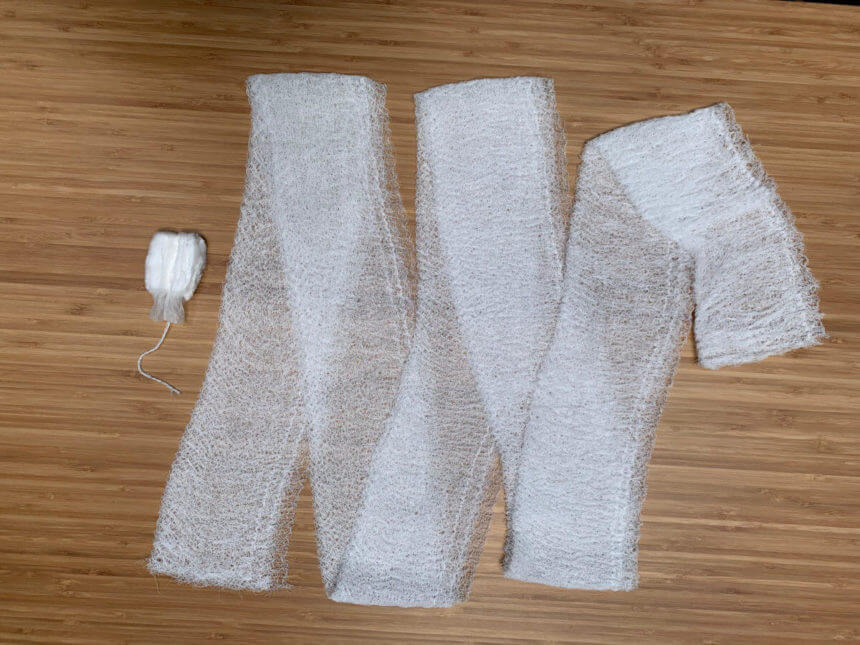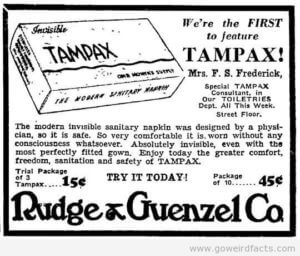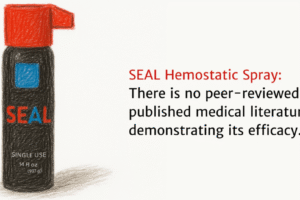
Heavy flow is not massive hemorrhage: Tampons don’t belong in IFAKs
- Posted by Mike Shertz MD/18D
- Categories (M) Massive Hemorrhage, Equipment
🕖 Reading Time, 6 minutes
Recently we posted a video outlining the challenges of using hemostatic granules as compared to gauze. In response, we were surprised by how many people advocated for tactical tampons to control massive hemorrhage in a gunshot wound. “Depending on the bullet hole size, tampon and pads are your best bets…” Or, “A tampon would have done the same thing.” Not true.
Tampons will not control massive or life-threatening bleeding.
It’s not their job and it’s beyond their capability. While many have written on the fallacy of using tampons for hemorrhage control and wound packing in massively bleeding wounds,1, 2 there are still those on the internet who continue to endorse this misguided technique.
I can find no peer-reviewed medical literature describing or testing the use of a tampon on traumatic bleeding wounds.
Although anecdotal stories of tampons being used in military settings for hemorrhage control may exist, using a tampon as a bandage or “blood sponge” is very different than trying to stop massive hemorrhage with one. Even if the often-referenced Snopes.com cite about a Marine being saved by a tampon placed in his wound by his buddy is true, it doesn’t prove the veracity of the technique.3
The military has a long history of one generation handing down unofficial lessons learned to the next generation. It seems possible some military medic somewhere was told, “it was the way to go,” but it doesn’t mean it works. When I was in the Special Forces Medical Sergeant’s course in 1987, we trained extensively on live tissue. I remember specifically being told the instructors had tried tampons for hemorrhage control, but they were never effective.
Named arteries (generally the larger ones such as the axilla, brachial, radial, etc) can bleed several hundred milliliters of blood per minute when perforated. (200 milliliters is about 40 teaspoons for those metric-adverse, or 4 shot glasses if that’s your preferred unit of measure). Prehospital hemorrhage control options for this kind of bleeding are tourniquets, if the bleeding source is amenable to circumferential pressure, for instance, a limb, or wound-packing if the bleeding is in “junctional areas” like the neck, axilla, and groin.
To control life-threatening hemorrhage anywhere in the body, the goal is to stop the bleeding.
That is generally accomplished by encouraging the blood to clot and essentially “seal the hole” in the bleeding blood vessel. With wound packing, this is done by tightly packing gauze directly at the point of bleeding. When enough gauze is packed into the wound, the pressure exerted by the packing will actually be more than the bleeding blood vessel’s bleeding pressure. This slows or stops the bleeding and allows for clotting to occur. In a ballistic gel wound model, measuring a volume of 53 ml, a Kerlix–like gauze exerted 156 mmHg pressure in the wound when packed by well-trained combat medics.4
Still inclined to keep tampons in your IFAK or first aid kit?
The average tampon contains approximately 2 – 2×4 inch pieces of gauze. Kerlix gauze is between 3.6-4.1 yards long. From a cost perspective, tampons also make no sense to stock in an IFAK. If a tampon costs $0.24 each (at bulk Amazon pricing) and is approximately 4” of gauze, it would take $8.64 worth of tampons to equal the length of packing material in one $1.99 roll of Kerlix (at non-bulk pricing). If someone is bleeding to death from a junctional wound, shoving a 4×4 in the wound is not going to accomplish the same thing as 156mmHg pressure from 12 feet of gauze.4
Hemostatic gauzes help with clotting by providing pro-coagulant materials or mucoadhesives, thus making it easier for blood to clot. The goal of the packed gauze isn’t to absorb blood, but to encourage clotting. That is exactly how direct pressure works. Provide so much pressure on the bleeding site that blood can’t come out, which allows the clot to form. With no pressure, the blood keeps washing the body’s efforts to form a clot out with the blood. If you need to improvise to pack a wound, there are much better and readily available choices than a tampon, including strips of fabric.
Tampons are not designed to stop bleeding, but rather simply absorb it.
“The function of the internal tampon is to absorb menstrual blood inside the vagina after it has left the uterus, preventing it from leaking out, and thus providing suitable protection with total discretion.”5
How much blood does a woman actually even lose during menses? “Most women will lose less than 80 ml (16 teaspoons) of blood during their period, with the average being around 6 to 8 teaspoons. Heavy menstrual bleeding is defined as losing more than 80 ml with each period.” Remember a shot glass is 50 ml. Though inconvenient, this is not a lot of bleeding.6
How much blood is the most absorbent tampon made to soak up? The most absorbent tampons manufactured are “Ultra-absorbency Tampons” which absorb up to 17 ml of menstrual blood.7
For a little history on the tampon, there are different accounts of its first use. Women have been fashioning solutions to absorb menstrual flow since the Egyptian era, including intravaginally. The first commercial applicator tampon was created by Dr. Earle Cleveland Hass. Dr. Haas obtained a patent for this tampon in 1933. He combined the terms “tampon” and “vaginal packs” to create “Tampax”.8
Andrew Fisher, in his article for Havoc Journal, noted that “Kimberly-Clark, which produces Kotex ® did make and provide Cellucotton, an absorbent wadding made of wood pulp as bandages.” Apparently, WWI field nurses figured out that material made a reasonable disposable female napkin. He also stated that “production of cotton bandages and surgical dressings for the US military now took place alongside the tampon assembly lines” during WW2.1
Interested in more information on wound packing? You can watch a sample video demonstrating 4-different ways.
Interested in learning how to stop massive hemorrhage and be an immediate responder in an emergency? Try our online courses, or get started with a sample of the material in the preview course
Footnotes
1 Havoc Journal“, Your Tactical Tampon is Useless for Life-Threatening Hemorrhage.” Andrew Fisher, January 15, 2019.
2Private Bloggins “Hemorrhage Control – What Aunt Flow Didn’t Know.” Chris, January 28, 2015.
3 Snopes.com Tampon Wound Dressing, Tampon used to stanch deadly wound saves Marine’s life? David Mikkelson, October, 20017
4 American Journal of Emergency Medicine, Gauze vs XSTAT in wound packing for hemorrhage control. Kragh MD, et. al, July 2015.
5 A study on the microbial quality of sealed products for feminine hygiene R. Briancesco et al. September, 2018
6 UK National Health Service, Heavy periods are common, but they can have a big effect on a woman’s everyday life. Author unknown, revised June 7, 2018.
7 Very Well Health, What Tampon Absorbency Ratings Mean. Tracee Cornforth, May 22, 2019.
8 The Atlantic, The Tampon: A History – The cultural, political, and technological roots of a fraught piece of cotton. Ashley Fetters, June 1, 2015
Tag:IFAK
Dr. Mike Shertz is the Owner and Lead Instructor at Crisis Medicine. Dr. Shertz is a dual-boarded Emergency Medicine and EMS physician, having spent over 30 years gaining the experience and insight to create and provide his comprehensive, science-informed, training to better prepare everyday citizens, law enforcement, EMS, and the military to manage casualties and wounded in high-risk environments. Drawing on his prior experience as an Army Special Forces medic (18D), two decades as an armed, embedded tactical medic on a regional SWAT team, and as a Fire Service and EMS medical director.
Using a combination of current and historical events, Dr. Shertz’s lectures include relevant, illustrative photos, as well as hands-on demonstrations to demystify the how, why, when to use each emergency medical procedure you need to become a Force Multiplier for Good.
You may also like
Leave A Reply
You must be logged in to post a comment.







1 Comments
Thanks for clearing that up. It’s helpful. Tampons are blood sponges, not for junctional occlusion.